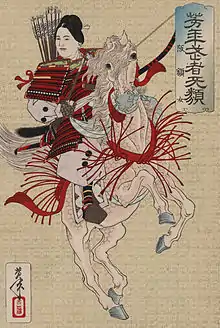Hangaku Gozen
Lady Hangaku (坂額御前, Hangaku Gozen)[1] was a onna bugeisha warrior, one of the relatively few Japanese warrior women commonly known in history or classical literature.

Early life
She lived during the end of the Heian and the beginning of the Kamakura periods. Her other names include Hangaku (板額 or 飯角). She was the daughter of a warrior named Jō Sukekuni (城資国), and her siblings were Jō Sukenaga (城資永) and Jō Nagamochi (城長茂) (or Sukemochi (助茂)).
Career and capture
In 1180-1185 Tomoe Gozen fought in the Genpei War alongside men.[2] The Jō were warriors, allies of the Taira clan, in Echigo Province (present-day Niigata Prefecture). They were defeated in the Genpei Wars, and lost most of their power. In 1201, together with her nephew Jō Sukemori (城資盛), she raised an army in response to Sukemoto's attempt (the Kennin Uprising) to overthrow the Kamakura Shogunate. Hangaku and Sukenaga took a defensive position at a fort at Tossakayama under attack from Sasaki Moritsuna (佐々木盛綱). Hangaku commanded 3,000 soldiers to defend against an army of 10,000 soldiers loyal to the Hōjō clan.
Ultimately she was wounded by an arrow and captured; the defenses then collapsed. Hangaku was taken to Kamakura. When she was presented to the shōgun Minamoto no Yoriie, she met Asari Yoshitō (浅利義遠), a warrior of the Kai-Genji clan, who received the shōgun's permission to marry her. They lived in Kai, where she is said to have had one daughter.
Culture references
Hangaku appears in the Azuma Kagami.[3]
Hangaku is said to have been "fearless as a man and beautiful as a flower,"[4] and to have wielded a naginata in battle. Many storytellers and printmakers have portrayed her in their works, including Kuniyoshi, who produced a series of warrior women prints. This series also included such historical or literary figures as Tomoe Gozen, Shizuka Gozen, and Hōjō Masako.
References
- Note: Gozen is not a name, but rather an honorific title, usually translated to "Lady", though the title was rarely bestowed upon men as well.
- Deal, William E. (2007). Handbook to Life in Medieval and Early Modern Japan. Oxford University Press, US. p. 48. ISBN 978-0-19-533126-4.
- Archived September 12, 2005, at the Wayback Machine
- Beard, Mary (1953). The Force of Women in Japanese History. Public Affairs Press. pp. 72–73. Cited by Cook, Bernard (2006). "Japan, Women Warriors in Ancient and Medieval Japan". Women and War: A Historical Encyclopedia from Antiquity to the Present. ABC-CLIO. pp. 326–327. ISBN 9781851097708.